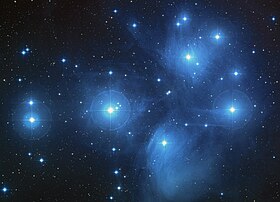Merope (star)
 | |
| Observation data Epoch J2000 Equinox J2000 | |
|---|---|
| Constellation | Taurus |
| Right ascension | 03h 46m 19.57384s[1] |
| Declination | 23° 56′ 54.0812″[1] |
| Apparent magnitude (V) | 4.18[2] |
| Characteristics | |
| Spectral type | B6IV(e)[3] |
| U−B color index | -0.41[4] |
| B−V color index | -0.06[4] |
| Variable type | β Cephei[5] |
| Astrometry | |
| Radial velocity (Rv) | 6.2[6] km/s |
| Proper motion (μ) | RA: 21.13[1] mas/yr Dec.: -43.65[1] mas/yr |
| Parallax (π) | 8.58 ± 0.37[1] mas |
| Distance | 380 ± 20 ly (117 ± 5 pc) |
| Details | |
| Mass | 4.8-5.0[7] M☉ |
| Radius | 5.1[8] R☉ |
| Surface gravity (log g) | 4.0[8] cgs |
| Temperature | 13,360 ± 340[8] K |
| Other designations | |
| Database references | |
| SIMBAD | data |
Merope /ˈmɛrəpiː/,[9] designated 23 Tauri (abbreviated 23 Tau), is a star in the constellation of Taurus and a member of the Pleiades star cluster. It is approximately 380 light years away.
Description[]
Merope is a blue-white B-type subgiant with a mean apparent magnitude of +4.14. Richard Hinckley Allen described the star as lucid white and violet.[10] It has a luminosity of 630 times that of the Sun and a surface temperature of 14,000 kelvins. Merope's mass is roughly 4.5 solar masses and has a radius more than 4 times as great as the Sun's. It is classified as a Beta Cephei type variable star and its brightness varies by 0.01 magnitudes.[5]
Surrounding Merope is the Merope Nebula (NGC 1435). It appears brightest around Merope and is listed in the Index Catalogue as number IC 349.
Nomenclature[]
23 Tauri is the star's Flamsteed designation. The name Merope originates with Greek mythology; she is one of the seven daughters of Atlas and Pleione known as the Pleiades. In 2016, the International Astronomical Union organized a Working Group on Star Names (WGSN)[11] to catalog and standardize proper names for stars. The WGSN's first bulletin of July 2016[12] included a table of the first two batches of names approved by the WGSN; which included Merope for this star. It is now so entered in the IAU Catalog of Star Names.[13]
References[]
- ^ a b c d e Van Leeuwen, F (2007). "Validation of the new Hipparcos reduction". Astronomy and Astrophysics. 474 (2): 653–664. arXiv:0708.1752. Bibcode:2007A&A...474..653V. doi:10.1051/0004-6361:20078357. S2CID 18759600.
- ^ Ducati, J. R (2002). "VizieR Online Data Catalog: Catalogue of Stellar Photometry in Johnson's 11-color system". CDS/ADC Collection of Electronic Catalogues. 2237. Bibcode:2002yCat.2237....0D.
- ^ Slettebak, A (1982). "Spectral types and rotational velocities of the brighter Be stars and A-F type shell stars". Astrophysical Journal Supplement Series. 50: 55. Bibcode:1982ApJS...50...55S. doi:10.1086/190820.
- ^ a b Crawford, D. L.; Barnes, J. V.; Golson, J. C. (1971), "Four-color, Hbeta, and UBV photometry for bright B-type stars in the northern hemisphere", The Astronomical Journal, 76: 1058, Bibcode:1971AJ.....76.1058C, doi:10.1086/111220
- ^ a b Samus, N. N.; Durlevich, O. V.; et al. (2009). "VizieR Online Data Catalog: General Catalogue of Variable Stars (Samus+ 2007-2013)". VizieR On-line Data Catalog: B/GCVS. Originally Published in: 2009yCat....102025S. 1. Bibcode:2009yCat....102025S.
- ^ Wilson, Ralph Elmer (1953). "General catalogue of stellar radial velocities". Washington. Bibcode:1953GCRV..C......0W.
- ^ Zorec, J.; Frémat, Y.; Cidale, L. (2005). "On the evolutionary status of Be stars. I. Field Be stars near the Sun". Astronomy and Astrophysics. 441 (1): 235–248. arXiv:astro-ph/0509119. Bibcode:2005A&A...441..235Z. doi:10.1051/0004-6361:20053051. S2CID 17592657.
- ^ a b c Underhill, A. B.; et al. (November 1979), "Effective temperatures, angular diameters, distances and linear radii for 160 O and B stars", Monthly Notices of the Royal Astronomical Society, 189 (3): 601–605, Bibcode:1979MNRAS.189..601U, doi:10.1093/mnras/189.3.601
- ^ Davis, George A. (1944). "The pronunciations, derivations, and meanings of a selected list of star names". Popular Astronomy. 52: 8–30. Bibcode:1944PA.....52....8D.
- ^ Merope, Star Names and their Meanings, Richard Hinckley Allen, Dover Publications, 1963, p. 407.
- ^ "IAU Working Group on Star Names (WGSN)". Retrieved 22 May 2016.
- ^ "Bulletin of the IAU Working Group on Star Names, No. 1" (PDF). Retrieved 28 July 2016.
- ^ "IAU Catalog of Star Names". Retrieved 28 July 2016.
External links[]
| Wikimedia Commons has media related to Merope (star). |
- Jim Kaler's Stars, University of Illinois:Merope (23 Tauri)
- NGC 1435 - Merope Nebula LRGB image with 4 hours total exposure.
Coordinates: ![]() 03h 46m 19.5739s, +23° 56′ 54.090″
03h 46m 19.5739s, +23° 56′ 54.090″
- Flamsteed objects
- Taurus (constellation)
- Beta Cephei variables
- Pleiades Open Cluster
- B-type subgiants
- Stars with proper names
- HR objects
- Hipparcos objects
- Henry Draper Catalogue objects
- Durchmusterung objects
- Multiple star systems
- Objects with variable star designations